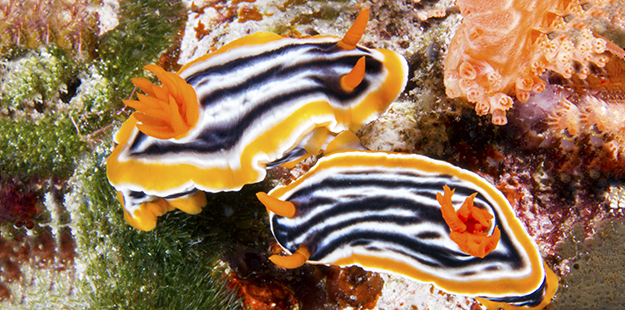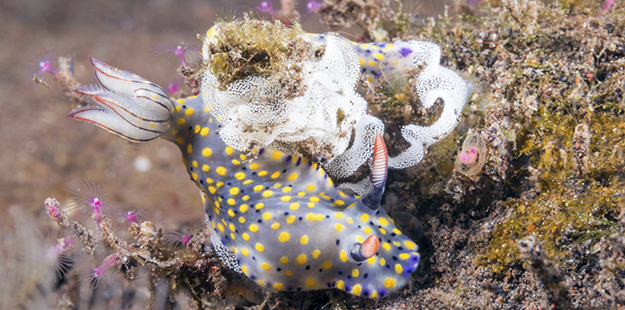Butterflies of the Sea
Sex in the slow lane
When a nudibranch goes looking for love, it depends on the slime trail left by others of its species to show it the way. A slug in search of companionship will follow the scent trail in a slow motion pursuit. When it finally makes contact, the suitor will touch the tail of it’s intended mate. It may take some time for the lead animal to get the message, but when it does the two begin a slow circling motion that puts them head to tail. Most nudibranchs have reproductive genital openings on the right-hand sides of their upper bodies, and this maneuver puts those organs in contact. At this point, the whole concept of male and female takes a twist in the nudibranch world, because they are fully functional hermaphrodites, equipped with male and female sex organs. In some species, there is an initial vying to decide which animal will fulfill which role, but in most cases, they settle for both.

Most nudibranchs, like these Chromodoris magnifica, have reproductive genital openings on the right side of their upper bodies, so they can easily connect those organs. Photo by Walt Stearns

The egg ribbons, or coils of encasing jelly secreted by nudibranchs, can contain up to two million eggs, and are typically laid near a food source. Photo by Walt Stearns
When the mating begins, both nudibranchs will extend a penis that seeks out the other’s female genitalia. Depending on the species, copulation can last from minutes to days. And sex isn’t always a couple’s affair. If more than one nudibranch smells the possibility the tryst, they will follow the slime trail and join the party, lining up to form rings of four or more animals in an orgy of procreation. Once all is consummated, each slug goes its separate way with a belly full of fertilized eggs, and seeks out a good location to create the coils or spirals of encasing jelly known as egg ribbons. The egg ribbons secreted by nudibranchs are often colorful and intricate. They make no attempt to hide their encapsulated offspring, because these ribbons can be as toxic as the slugs themselves. Ribbons can contain up to two million eggs, and are typically laid near a food source. After the ribbon is completed, the parent moves on, leaving the larvae to fend for themselves once they hatch.

Unlike most nudibranchs, flatworms have neither rhinophores nor exposed feathery gills. Photo by Wakatobi Dive Resort
Flat like a leaf
Should you come across what seems to be a free-swimming nudibranch, it’s probably a flatworm. Flatworms are similar to nudibranchs in many ways, although unlike most nudis, flatworms have neither rhinophores nor exposed feathery gills. Some have marginal tentacles at one end, which may contain simple eyes, and other species may have dorsal tentacles issuing from the back near the head. Basically, flatworms are just that, worms, not mollusks. Like nudibranchs, they come in remarkable range of colors, featuring intricate patterns. And that’s where their similarities end. All you need to remember, if it’s flat like a leaf, it’s a flatworm.
Finding nudis
Though some number of nudibranchs can be found in most any of the world’s oceans, the greatest concentrations occur in tropical waters and in places such as Wakatobi. In fact, there’s a good chance of seeing a nudibranch on most any dive at the resort. The sponge-eating phyllidia varicosa is very common on Wakatobi’s reefs and is easily recognized by the longitudinal, blue-gray ridges on it’s back, which are accented by yellow-capped tubercles. Another colorful character to look for is the lovely Hypselodoris bullocki. This species secretes it’s own toxins, and one nibble is usually sufficient to teach a predator that it is a bitter mouthful. Scientists believe that the natural toxins produced by reef invertebrates such as this may have future commercial or medicinal applications. Another favorite find in Wakatobi waters is the Chromodoris magnifica, which sports a distinctive band of orange around its body, and displays equally vibrant rhinophores and gills. If the orange strip is missing, you’ve found the closely related Chromodoris willani.

Scientists believe that the natural toxins produced by reef invertebrates such as this Banana nudibranch may have future commercial or medicinal applications. Photo by Ron Lucas
Making a positive ID on any given nudibranch can sometimes be a challenge, as coloration and patterning can vary with each individual. Fortunately, you have plenty of time to study each specimen, because they aren’t going to run away. Given their inability to escape, and their vulnerability to things that want to touch rather than eat them, it’s best to respect the boundaries of these slow moving butterflies of the sea. For much like their butterfly counterparts, nudibranchs have only a short time to display their resplendence. Some may survive for a year, but others live only a few weeks as adults. So when you come across a nudibranch at Wakatobi, don’t touch, and enjoy the sight of one of nature’s most colorful creations.
Ready for a slugfest at Wakatobi? Contact us at office@wakatobi.com or complete a quick trip inquiry at wakatobi.com.
View more great Wakatobi imagery visit us on TUMBLR.
Visit us on Facebook.


